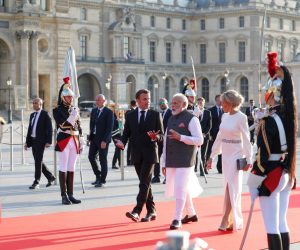Indian Prime Minister Narendra Modi was in France on a two-day official visit on July 13-14. Modi was the guest of honor at the French National Day celebrations, and the visit also coincided with the 25th anniversary of the establishment of the India-France Strategic Partnership. Going by the number of documents signed and issued, which included a Joint Communique, Horizon 2047 – 25th Anniversary of the India-France Strategic Partnership, Towards a Century of India-France Relations, a List of Outcomes, and the India-France Indo-Pacific Roadmap, the visit appears to have been a successful one.
The visit’s defense agenda appears to have received the most attention, with India’s plans for the acquisition of Rafale jets and Scorpene submarines figuring prominently, but there is less clarity on what has been achieved and how quickly these platforms will be delivered.
The India-France bilateral relationship was elevated to a Strategic Partnership in January 1998 by Prime Minister Atal Bihari Vajpayee and President Jacques Chirac. France has continued to enjoy enormous goodwill among India’s political elite as well as the public at large. As the joint communique noted, the relationship has seen “a strong and steady partnership of exceptional endeavors” from the time India gained its independence in 1947. The Joint Communique issued after the meeting between Modi and French President Emmanuel Macron said that the two leaders “agreed that ours is a relationship that has been resilient in the darkest storms and bold and ambitious in riding the high tides of opportunities.” It also underscored that the relationship is built on “shared values, belief in sovereignty and strategic autonomy, an unwavering commitment to international law and the U.N. Charter, an abiding faith in multilateralism, and a common quest for a stable multipolar world.”
Expanding defense cooperation was high on the agenda for both India and France. Modi remarked that defense ties “have always been the basic foundation of our relations. This is a symbol of the deep trust between the two nations . . . Be it submarines or Indian Naval ships, together we want to fulfill not just ours but also the requirements of other friendly countries.” Strangely, Scorpene submarines and Rafale fighters for the Indian Navy were not mentioned in the joint statement, which suggest that these negotiations are not yet complete.
India’s plans to acquire fighter jets and Scorpene submarines were cleared by the Indian Defense Ministry prior to the issuance of the Joint Statement. The defense minister-led Defense Acquisitions Council had given the “acceptance of necessity” to these two acquisitions for the Indian Navy at an estimated cost of 800 billion Indian rupees (approximately 9 billion euros). But according to sources who spoke to Indian media, the actual signing of contracts for these two procurements will happen only after “extensive techno-commercial negotiations” that will likely take several months if not years (if one were to go by the MMRCA negotiations), and the deal will then be approved by the Indian Cabinet Committee on Security.
The new Scorpene submarines are to be constructed at the Mazagon Docks Ltd in Mumbai. They will be equipped with air-independent propulsion (AIP) systems developed by the Indian Defense Research and Development Organization (DRDO). The AIPs provide the ability for submarines to stay underwater for longer duration than a non-AIP diesel submarine. This technology is not present in any of India’s current submarines. The old Scorpene submarines developed earlier under Project 75 will also be retrofitted with the DRDO’s AIP in the coming years.
These two deals along with other defense items are mentioned in the Horizon 2047 document, which is a document mapping the future of India-France strategic partnership. The document was issued following the Modi-Macron meeting and identifies key areas of collaboration including defense, outer space, science and technology, as well as a pledging to strengthen multilateralism.
In addition to highlighting the 36 Rafale jets ordered by India, it noted that India and France will collaborate “in advanced aeronautical technologies by supporting the joint development of a combat aircraft engine.” The two countries are also looking to strengthen industrial partnership for the motorization of heavy-lift helicopters under the Indian Multi Role Helicopter initiative with the use of France’s Safran Helicopter engine. To further this cooperation, a shareholders agreement has been entered into between Hindustan Aeronautics Limited and Safran. The two also signed a contract in order to facilitate transfer of technology of forging and castings for the Shakti engine.
On the Scorpene submarine deal, the Horizon 2047 document said that given their past collaboration on submarine construction under the P75 Kalvari series submarines, the two countries have agreed to delve into “more ambitious projects” in order to step up India’s submarine fleet and performance. Similarly, Garden Reach Shipbuilders and Engineers Ltd, and Naval Group France, a prominent naval industry player, have signed an MoU to work on surface ships, to meet the requirements of India as well as that of that of international naval forces. The India-France Indo-Pacific Roadmap also made similar assertions, saying that the two sides will “develop defense industrial capabilities in India and jointly support the needs of other countries.”
That these deals were not mentioned or were possibly removed from the original joint statement suggest that there is a long way to go for the actual materialization of these capabilities for the Indian armed forces. Given that the MMRCA decision-making went on for 20 years and that finally India decided to buy 36 fighters off-the-shelf makes one somewhat less optimistic about possible timelines on these deals, whenever they are worked out.

































